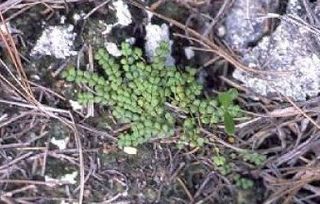
Euphorbia is a very large and diverse genus of flowering plants, commonly called spurge, in the family Euphorbiaceae. "Euphorbia" is sometimes used in ordinary English to collectively refer to all members of Euphorbiaceae, not just to members of the genus.

Euphorbia amygdaloides, the wood spurge, is a species of flowering plant in the family Euphorbiaceae, native to woodland locations in Europe, Turkey and the Caucasus. It is a bushy evergreen perennial, growing to a height of 80 cm (31 in), with dark green slightly hairy leaves about 6 cm (2 in) long. The complex green-yellow inflorescence (cyathium), typical of Euphorbia, appears in late spring and early summer.

Euphorbia milii, the crown of thorns, Christ plant, or Christ's thorn, is a species of flowering plant in the spurge family Euphorbiaceae, native to Madagascar. The species name commemorates Baron Milius, once Governor of Réunion, who introduced the species to France in 1821.

Euphorbia peplus, is a species of Euphorbia, native to most of Europe, northern Africa and western Asia, where it typically grows in cultivated arable land, gardens and other disturbed land.
Euphorbia tannensis subsp. eremophila, commonly known as desert spurge, is a subspecies of herb or shrub native to Australia.
Euphorbia tannensis var. eremophila is the more widespread variety of E. tannensis subsp. eremophila.

Euphorbia prostrata is a species of spurge known by the common name prostrate spurge or prostrate sandmat.

Euphorbia celastroides is a flowering plant in the family Euphorbiaceae. It is referred to by the common name 'akoko by Hawaiians, and is a species of spurge closely related to the poinsettia. This species develops into a round-shape shrub. This species is endemic to the Hawaiian Islands.
Aphthona nigriscutis is a root-feeding flea beetle of the genus Aphthona. It is one of five Aphthona spp. that has been used in Alberta, Canada to control leafy spurge, an invasive plant that reduces pasture quality and degrades natural habitats. It, along with A. lacertosa, is one of only two biocontrol agents thought to be effective against leafy spurge.

Euphorbia deltoidea is a species of flowering plant endemic to Florida in the United States. The taxonomy of the plant is difficult, with some authorities dividing it into four subspecies and some into three; also, it is frequently listed as a member of the old genus Chamaesyce. One subspecies, ssp. deltoidea, is a federally listed endangered species called deltoid spurge. It is found only in Miami-Dade County. Another subspecies, ssp. adhaerens, is often included with it under the name deltoidea instead of separately, making it difficult to keep count of how many endangered plants there are. This is generally dealt with by placing the "endangered species" label on any taxon within the species that is limited to Miami-Dade County, however many names they may have.

Euphorbia davidii, known as David's spurge or toothed spurge, is a species of flowering plant in the spurge family Euphorbiaceae. It is an annual herb growing up to 2 feet tall. Leaves are opposite in arrangement with narrow to broadly elliptic blades.

Euphorbia ouachitana, commonly called Ouachita spurge, is a species of flowering plant in the spurge family (Euphorbiaceae). It is native eastern to North America, where its range is restricted to the Ouachita and Ozark Mountains, with disjunct populations east in the Nashville Basin. Its typical natural habitat is semi-open forests and woodlands, usually associated with thin soils underlain by shale or limestone.

Euphorbia mauritanica, commonly known as yellow milk bush or golden spurge, is a species of plant in the family Euphorbiaceae native to Africa.










